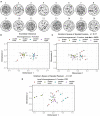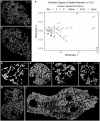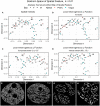A novel statistical methodology for quantifying the spatial arrangements of axons in peripheral nerves
- PMID: 36968498
- PMCID: PMC10034020
- DOI: 10.3389/fnins.2023.1072779
A novel statistical methodology for quantifying the spatial arrangements of axons in peripheral nerves
Abstract
A thorough understanding of the neuroanatomy of peripheral nerves is required for a better insight into their function and the development of neuromodulation tools and strategies. In biophysical modeling, it is commonly assumed that the complex spatial arrangement of myelinated and unmyelinated axons in peripheral nerves is random, however, in reality the axonal organization is inhomogeneous and anisotropic. Present quantitative neuroanatomy methods analyze peripheral nerves in terms of the number of axons and the morphometric characteristics of the axons, such as area and diameter. In this study, we employed spatial statistics and point process models to describe the spatial arrangement of axons and Sinkhorn distances to compute the similarities between these arrangements (in terms of first- and second-order statistics) in various vagus and pelvic nerve cross-sections. We utilized high-resolution transmission electron microscopy (TEM) images that have been segmented using a custom-built high-throughput deep learning system based on a highly modified U-Net architecture. Our findings show a novel and innovative approach to quantifying similarities between spatial point patterns using metrics derived from the solution to the optimal transport problem. We also present a generalizable pipeline for quantitative analysis of peripheral nerve architecture. Our data demonstrate differences between male- and female-originating samples and similarities between the pelvic and abdominal vagus nerves.
Keywords: Sinkhorn distance; neuroanatomy; neuromodulation; optimal transport problem; peripheral nervous system; spatial point process.
Copyright © 2023 Shemonti, Plebani, Biscola, Jaffey, Havton, Keast, Pothen, Dundar, Powley and Rajwa.
Conflict of interest statement
The authors declare that the research was conducted in the absence of any commercial or financial relationships that could be construed as a potential conflict of interest.
Figures














References
-
- Ahuja R. K., Magnanti T. L., Orlin J. B. (1993). Network Flows - Theory, Algorithms and Applications. Prentice Hall.
-
- Avis D. (1980). On the extreme rays of the metric cone. Can. J. Math. 32, 126–144. 10.4153/CJM-1980-010-0 - DOI
-
- Baddeley A., Rubak E., Turner R. (2015). Spatial Point Patterns: Methodology and Applications With R. London: Chapman and Hall; CRC Press. 10.1201/b19708 - DOI
-
- Baddeley A. J., Møller J., Waagepetersen R. (2000). Non- and semi-parametric estimation of interaction in inhomogeneous point patterns. Stat. Neerland. 54, 329–350. 10.1111/1467-9574.00144 - DOI
Grants and funding
LinkOut - more resources
Full Text Sources

